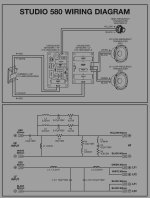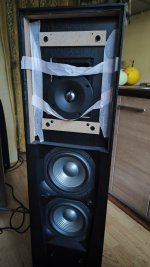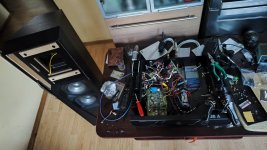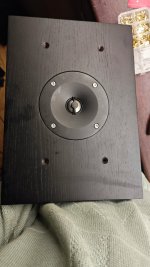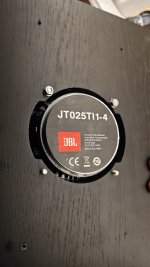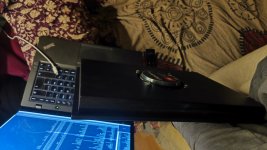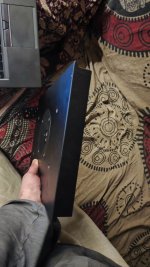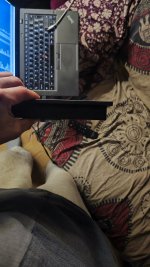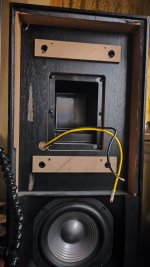Hey Guys,
While I'm repairing (hopefully I'm gonna be successful) my Tandberg 3026A MOSFET Power Amp (was their TOTL at the time, their engineers and people involved went on to work at/found Electrocompaniet, Dynamic Precision, Hegel) I'm also doing a 2 way speaker modification that I am kind of taking a gamble on, because I'm not really 100% sure how these things work.
I have JBL Studio 580 that are budget, but pretty interesting speakers, however their horn driver crossed over at 1500 Hz really lacked definition or beauty and just didn't do justice to my amplification. However I really really like the titanium tweeter in the new JBL classic line (L100 and L82 classic) and since I know that L82 crosses over at 1700 Hz I thought I'd give it a shot. I tried connecting it directly to my amp with DSP and it's pretty much linear from 1500 Hz and the same cannot be said about the horn driver that was originally in the speaker. So now I just want to create a third order filter (like is also found on the bass drivers in my 580 or at least I think it's third order based on my limited understanding) and put very simple third order filter on the titanium tweeter. I already tried integrating it with DSP and it works beautifully. Now I just need passive crossover and I'd like to utilize the components that are already present in the high pass filter. The level I will adjust easily with a resistors, but since the original horn driver had a high frequency roll off and some other irregularities, the high pass filter doesn't work with my titanium tweeter. Could somebody point me in the right direction in terms of what should I remove from this circuit to make it the most basic third order filter, what should I add?
So yeah, looking for advice that a novice like me could take action on in terms of modifying and simplifying this crossover, namely the high pass filter. Many thanks 🙏🏻
While I'm repairing (hopefully I'm gonna be successful) my Tandberg 3026A MOSFET Power Amp (was their TOTL at the time, their engineers and people involved went on to work at/found Electrocompaniet, Dynamic Precision, Hegel) I'm also doing a 2 way speaker modification that I am kind of taking a gamble on, because I'm not really 100% sure how these things work.
I have JBL Studio 580 that are budget, but pretty interesting speakers, however their horn driver crossed over at 1500 Hz really lacked definition or beauty and just didn't do justice to my amplification. However I really really like the titanium tweeter in the new JBL classic line (L100 and L82 classic) and since I know that L82 crosses over at 1700 Hz I thought I'd give it a shot. I tried connecting it directly to my amp with DSP and it's pretty much linear from 1500 Hz and the same cannot be said about the horn driver that was originally in the speaker. So now I just want to create a third order filter (like is also found on the bass drivers in my 580 or at least I think it's third order based on my limited understanding) and put very simple third order filter on the titanium tweeter. I already tried integrating it with DSP and it works beautifully. Now I just need passive crossover and I'd like to utilize the components that are already present in the high pass filter. The level I will adjust easily with a resistors, but since the original horn driver had a high frequency roll off and some other irregularities, the high pass filter doesn't work with my titanium tweeter. Could somebody point me in the right direction in terms of what should I remove from this circuit to make it the most basic third order filter, what should I add?
So yeah, looking for advice that a novice like me could take action on in terms of modifying and simplifying this crossover, namely the high pass filter. Many thanks 🙏🏻
Attachments
Last edited:
The 580 crossover is interesting, the two LCR series circuits that are bypassing the 18 ohm resister are there to give a 6db boost in the highest octave, no doubt to compensate for the effect of the horn and the compression driver. So they would be the first thing to go if you are replacing the existing tweeter. The next thing you need to do is find out the specs of the tweeter you want to use, is pulled from a JBL L100 or is it something built by a known manufacture with published data? There is a series notch, this is designed for the existing driver so it will need to be with one that matches the resonant frequency of the replacement tweeter. The inductor in series with 4.3 ohm resister also boosts the hi frequency, so it will go, this is OK because both resistors will need to be changed. The reason is the existing horn loaded compression driver has a very high sensitivity vs. a titanium dome.
I did some searching and it looks like it uses these drivers.
2414H Compression driver
8 ohm
98db
565J Mid woofers
I can't find any specs
So you find the specs on the tweeter you want to use or better yet measure its frequency response mounted on the baffle and measure the impedance. Then measure the mid-woofers and it will be fairly simple to design a crossover.
I did some searching and it looks like it uses these drivers.
2414H Compression driver
8 ohm
98db
565J Mid woofers
I can't find any specs
So you find the specs on the tweeter you want to use or better yet measure its frequency response mounted on the baffle and measure the impedance. Then measure the mid-woofers and it will be fairly simple to design a crossover.
The titanium dome tweeter is JT025TI1-4 (people from ASR forum were unable to find the specs), the same that I have in the picture and the same that L82 and L100 classic have. When I measured it without baffle outputting sine wave straight from my amp it appeared to be very linear down to right around 1500 Hertz at which point it started dropping off and if I recall correctly 1200 Hz it looked pretty out of shape but it was totally fine until right around 1.5k. I know it crosses over at 1700 Hz in L82 classic, hence my gamble on buying these. Well, that and the fact that I really love how these tweeters sound. They have to me a little bit of that B&W 700 series tweeter sound which is super detailed and which I love. But since I have measured them to be pretty linear all the way to 1500 Hz I would like to just keep the filter on the bass drivers and come up with something for the high pass.
The 580 have pretty cool and interesting cabinets for the relatively low price that they used to sometimes go for. Pretty well braced and thick MDF boards with pretty much no parallel walls.
By the way the titanium dome tweeter is over twice the weight despite not being in a compression enclosure and the waveguide is plastic too. So while it's not as efficient, it's actually pretty efficient as a dome driver, definitely a lot more magnet on it. Still of course the resistors will have to be replaced. Should I just buy a bunch of cheap ones and see, listen, measure which ones work the best or how is that usually done?
Thank you very much for these insights, I will probably get rid of those parts and see what I need to do next. The impedance I haven't measured and I don't know how to do it (I do have a good multitester if that's how that is performed), but if I recall correctly the L82 and L100 have 8 and 4 Ohm impedance respectively. The baffles I ordered to be made from 30mm oak and they should be completed in 1 or 2 weeks.
The 580 have pretty cool and interesting cabinets for the relatively low price that they used to sometimes go for. Pretty well braced and thick MDF boards with pretty much no parallel walls.
By the way the titanium dome tweeter is over twice the weight despite not being in a compression enclosure and the waveguide is plastic too. So while it's not as efficient, it's actually pretty efficient as a dome driver, definitely a lot more magnet on it. Still of course the resistors will have to be replaced. Should I just buy a bunch of cheap ones and see, listen, measure which ones work the best or how is that usually done?
Thank you very much for these insights, I will probably get rid of those parts and see what I need to do next. The impedance I haven't measured and I don't know how to do it (I do have a good multitester if that's how that is performed), but if I recall correctly the L82 and L100 have 8 and 4 Ohm impedance respectively. The baffles I ordered to be made from 30mm oak and they should be completed in 1 or 2 weeks.
Last edited:
I use a Dayton Audio DATs v3 to measure impedance, it cost me $130.00. You can also build a jig for a few dollars and use an audio interface or a built in sound card to do the same thing, look for the ARTA manual for the schematic. You will need a microphone to measure the frequency response. Do some searches on measuring in this forum, also search for the VituixCAD guide to measurements. You should measure the LF section to find the actual acoustic slope, it most likely not be 3rd order, to decide what slope to put on the HF.
@Hotep
Here's a pic of the JBL L82 schematic ( it comes from an Italian review of the L82 > which I've included as a pdf file attached below ) .

Assuming you actually have the exact same tweeter as the L82 ( you didn't clearly state that, you just inferred it ), > then build up the high-pass portion of this pic and then give your new ad-hoc creation a listen.
The variable Lpad seen in the pic is most likely the 8 ohm variety.
🙂
Here's a pic of the JBL L82 schematic ( it comes from an Italian review of the L82 > which I've included as a pdf file attached below ) .
Assuming you actually have the exact same tweeter as the L82 ( you didn't clearly state that, you just inferred it ), > then build up the high-pass portion of this pic and then give your new ad-hoc creation a listen.
The variable Lpad seen in the pic is most likely the 8 ohm variety.
🙂
Attachments
Yes, I have the same exact tweeters as in L82 and L100.
Building just the high pass portion wouldn't work as I wish to keep the low pass filter, but it is crossed over at 1.5 khz. Still, thanks for the schematic, I might ultimately decide to just build 1.7 khz crossover from scratch, but I'll try modifying the existing high pass filter first, maybe use some DSP which I usually use anyway to bring it to where I want it.
I'll update when I make some progress on this.
Building just the high pass portion wouldn't work as I wish to keep the low pass filter, but it is crossed over at 1.5 khz. Still, thanks for the schematic, I might ultimately decide to just build 1.7 khz crossover from scratch, but I'll try modifying the existing high pass filter first, maybe use some DSP which I usually use anyway to bring it to where I want it.
I'll update when I make some progress on this.
So.... my usual question in these circumstances is why aren't you doing a complete analysis and simulation? That will best answer any questions about how to integrate a different HP filter and tweeter if you aren't going to change the LP section.
Lack of knowledge, experience and just knowing where to look for or what exactly for.
Also lack of proper mic, but I can easily get that.
Also the fact that I'd like to modify the existing HP filter if possible before deciding to build something from scratch and buy all new components.
By analysis I suppose you mean for the most part measuring how a sine sweep is played via a mic. Also impedance measurements, which I haven't gotten around to just yet and I don't know what I really need to have to perform that within my means. I know the Tweeter is very linear from 1.5 kHz and up. So I thought maybe I could just do the simplest version of a third order slope crossed over at 1.5 and call it a day and any other issues I can use DSP for to dial in and then upgrade the crossover once I get the most basic version running well. I'm sorry for my ignorance guys, I really appreciate you commenting and trying to help me out.
Also lack of proper mic, but I can easily get that.
Also the fact that I'd like to modify the existing HP filter if possible before deciding to build something from scratch and buy all new components.
By analysis I suppose you mean for the most part measuring how a sine sweep is played via a mic. Also impedance measurements, which I haven't gotten around to just yet and I don't know what I really need to have to perform that within my means. I know the Tweeter is very linear from 1.5 kHz and up. So I thought maybe I could just do the simplest version of a third order slope crossed over at 1.5 and call it a day and any other issues I can use DSP for to dial in and then upgrade the crossover once I get the most basic version running well. I'm sorry for my ignorance guys, I really appreciate you commenting and trying to help me out.
So I thought maybe I could just do the simplest version of a third order slope crossed over at 1.5 and call it a day and any other issues I can use DSP for to dial in
Don't do that man. Just don't. We hate this.
Your best, easiest way forward is to plan for a complete speaker analysis. You can do it all with REW or REW + Dayton DATS V3. Measure the impedance of the drivers in cabinet, the crossover values, and the driver responses without the crossover. If this is a two way you don't have to worry too much about quasi-anechoic reponses. Measuring at 3' / 1m is fine.
Room EQ Wizard (REW) has a little known feature that lets you use it as an impedance measurement tool. I've never done it but you can find it in the docs. I really like DATS.
Plug your FR and Z files into XSim and you'll be so much better and further off. Then people here can really help you. As a beginner, just the on-axis response is fine, but you may want to meausre at 45 degrees as well to understand where the mid-woofer becomes more directional. This may help you pick a better low pass point for the tweeter.
Attachments
Last edited:
Ok, thank you, sir, I will do my best.View attachment 1328921
Don't do that man. Just don't. We hate this.
Your best, easiest way forward is to plan for a complete speaker analysis. You can do it all with REW or REW + Dayton DATS V3. Measure the impedance of the drivers in cabinet, the crossover values, and the driver responses without the crossover. If this is a two way you don't have to worry too much about quasi-anechoic reponses. Measuring at 3' / 1m is fine.
Room EQ Wizard (REW) has a little known feature that lets you use it as an impedance measurement tool. I've never done it but you can find it in the docs. I really like DATS.
Plug your FR and Z files into XSim and you'll be so much better and further off. Then people here can really help you. As a beginner, just the on-axis response is fine, but you may want to meausre at 45 degrees as well to understand where the mid-woofer becomes more directional. This may help you pick a better low pass point for the tweeter.
Wouldn't standing waves in my room ruin the complete analysis? I don't really have an anechoic chamber, unless I go to a producer mixer friend of mine. Or is are measurements in a normal room with some acoustic flaws considered good enough generally?
Wouldn't standing waves in my room ruin the complete analysis?
Interfere with, yes, ruin no. Pull the speaker and mic out into the room as best you can, use gated/blended measurements (gated above 1 kHz, blended with ungated below) and don't sweat details below 100 Hz.
From an absolute perspective, close mic/quasi-anechoic measurements are best, but from a practical, useful point of view, gated 1m measurements are very very useful for most 2-way designs. What makes this easy is that you are trying to find the right crossover well above where room modes are at their worst. If you were trying to optimize filters below 200 Hz this may not work very well, but it works great for a 2-way at ~ 2kHz.
Also, doing this in room can help you get the right balance with "normal" room reinforcements if you ignore the squiggles in the bass. Also eliminates the need for additional baffle step calculations when analyzing. Lastly, it removes the need to measure and guess at the port contributions separately, which is math that is easy to get wrong.
So, for this reason you will be fine in this case, especially as a learning exercise. Ideally you'd have measured the original speaker so you have a reference curve to match in replacing the tweeter. You may not want to follow it exactly but you'd know how the speaker behaved before modifications.
The one remaining thing to learn as you do this is to get the acoustic offsets correct using interferometry. A fancy word for observing how the two drivers interfere with each other when there are no filters in place. If you get that wrong your simulated phase alignment will be wrong and so will your FR.
Last edited:
In the future, I think you'll start with speaker analysis first you may find yourself looking at different options rather than immediately jumping to a tweeter replacement. For instance, you might not like the levels between the two, or find you can improve the tweeter with some curve shaping (i.e. EQ) or find a better crossover point... etc.
The speaker analysis part of this work is what opens up a world of possibilities.
The speaker analysis part of this work is what opens up a world of possibilities.
That's a lot to digest for me Eric. Thanks for giving me a reference of where to start.
However, I'm pretty sure that the Tweeter replacement was the right move, because even using just crude DSP filters that I devised by ear and measuring with my phone, revealed very very enjoyable things in my music as expected. I've heard this Tweeter before (and I had it's little brother in L52 classic in my home for almost a year) and it's really way above and beyond the original horn loaded compression driver. In terms of fun, but definitely in terms of resolution. The horn driver was a total mush in the treble frequencies. It's only advantage was that it coupled better with air closer to the crossover frequency. But the voices, the resolution with this titanium dome tweeter, especially the female vocals is just night and day difference. And the cymbals and such is simply not comparable. The titanium dome makes them sound like they're right there in the room. It's really a great tweeter. The cheap crossover (L82/L100 also have cheap crossovers) muddles it a fair bit compared to DSP and straight from the amp with AudioQuest argent+ cables, but it's general quality is preserved, just sounds a bit tamer which is in a way even appreciated. In the end - so much more enjoyment at least for me. Driver integration might be worse, but that's probably because I got the DSP wrong. Or because, the tweeter is just more resolving than the two bass drivers and everything above a certain frequency sounds so much more refined and contains more information which higher frequencies already naturally contain more of. IDK. It's a fun experiment anyway and at the end of the day I will probably enjoy the results very much as well.
The one remaining bit that I don't understand in all of this is the phase relationship between the two bass drivers and the tweeter. How important is it and what can be done about it. With an active crossover which would be ideal here but is cost prohibitive at this point for me, it's easy to adjust the phase, but not so easy in a physical system with a passive crossover. I mean I won't be able to move the Tweeter closer or further away relative to the bass drivers. And the crossover is probably not of much use here either. Should I just completely not worry about the phase?
However, I'm pretty sure that the Tweeter replacement was the right move, because even using just crude DSP filters that I devised by ear and measuring with my phone, revealed very very enjoyable things in my music as expected. I've heard this Tweeter before (and I had it's little brother in L52 classic in my home for almost a year) and it's really way above and beyond the original horn loaded compression driver. In terms of fun, but definitely in terms of resolution. The horn driver was a total mush in the treble frequencies. It's only advantage was that it coupled better with air closer to the crossover frequency. But the voices, the resolution with this titanium dome tweeter, especially the female vocals is just night and day difference. And the cymbals and such is simply not comparable. The titanium dome makes them sound like they're right there in the room. It's really a great tweeter. The cheap crossover (L82/L100 also have cheap crossovers) muddles it a fair bit compared to DSP and straight from the amp with AudioQuest argent+ cables, but it's general quality is preserved, just sounds a bit tamer which is in a way even appreciated. In the end - so much more enjoyment at least for me. Driver integration might be worse, but that's probably because I got the DSP wrong. Or because, the tweeter is just more resolving than the two bass drivers and everything above a certain frequency sounds so much more refined and contains more information which higher frequencies already naturally contain more of. IDK. It's a fun experiment anyway and at the end of the day I will probably enjoy the results very much as well.
The one remaining bit that I don't understand in all of this is the phase relationship between the two bass drivers and the tweeter. How important is it and what can be done about it. With an active crossover which would be ideal here but is cost prohibitive at this point for me, it's easy to adjust the phase, but not so easy in a physical system with a passive crossover. I mean I won't be able to move the Tweeter closer or further away relative to the bass drivers. And the crossover is probably not of much use here either. Should I just completely not worry about the phase?
Last edited:
The one remaining bit that I don't understand in all of this is the phase relationship between the two bass drivers and the tweeter. How important is it and what can be done about it
This is why a simulator like XSim is very useful. It's very important, and if you get it wrong you end up applying gross global EQ (if possible) but also having disturbingly bad off-axis response. In the simulation you'll configure the driver to have a certain offset based on your interferometry results. That is, you may measure the woofer to be 2" behind the tweeter. Plug that in and then XSim will give you accurate phase and frequency plots.
In the passive crossover world we normally deal with this by making a variety of choices about the filter orders as well as the exact crossover values. This is at least one reason why you often see different order filters in 2-way speakers. For instance, 2nd order low pass with 3rd order high pass. In an active design we'd add digital delay to the tweeter, and then be able to pick our LP and HP filter curves without a concern for that.
Since you want to keep the LP filter and speaker, you don't have to measure each filter component there, just measure the combined impedance and FR and treat the whole thing as the woofer. Then you can simulate your tweeter and HP filter components
I have an idea. Grab XSim or VituixCAD. Without any driver measurements, go ahead and simulate the crossover, above. Then add some offset to the woofer. See what happens. 🙂
The neat thing about this is it's all free, and easy, and you can get a feel for how your choices affect results even if you don't have the measurements all done. Of course, don't build on this, but it will help your brain get a better understanding of the interactions involved.
The neat thing about this is it's all free, and easy, and you can get a feel for how your choices affect results even if you don't have the measurements all done. Of course, don't build on this, but it will help your brain get a better understanding of the interactions involved.
Hello good people,
Sorry for slow updates, the part I ordered took a while to get done.
This is just an oak board. Millimeter or two too narrow but otherwise quite perfect. I attached the CNC file if anyone wants to repeat it.
To be able to experiment with more different crossovers and not have to drop a bank on the parts as well as simplify the design and have much easier way to get time alignment I decided to go with digital crossovers and got myself a Topping DM7. Still working on some DIY amps and I need to make cables but I have pretty much all the parts I need, so it's just a matter of time now.
I will probably be using REW software, since it's freeware and I have Umik. I also have Equalizer EPO for global EQ on Windows.
Sorry for slow updates, the part I ordered took a while to get done.
This is just an oak board. Millimeter or two too narrow but otherwise quite perfect. I attached the CNC file if anyone wants to repeat it.
To be able to experiment with more different crossovers and not have to drop a bank on the parts as well as simplify the design and have much easier way to get time alignment I decided to go with digital crossovers and got myself a Topping DM7. Still working on some DIY amps and I need to make cables but I have pretty much all the parts I need, so it's just a matter of time now.
I will probably be using REW software, since it's freeware and I have Umik. I also have Equalizer EPO for global EQ on Windows.
Another perspective. The overall width is about 1.5mm to 2mm too narrow, otherwise turned out quite perfect. I am planning to replace the internal wiring.
This tweeter is on a completely different level relative to the original compression driver. It also goes pretty low comfortably.
This tweeter is on a completely different level relative to the original compression driver. It also goes pretty low comfortably.
Attachments
- Home
- Loudspeakers
- Multi-Way
- JBL Studio 580 to L100 Classic upgrade
